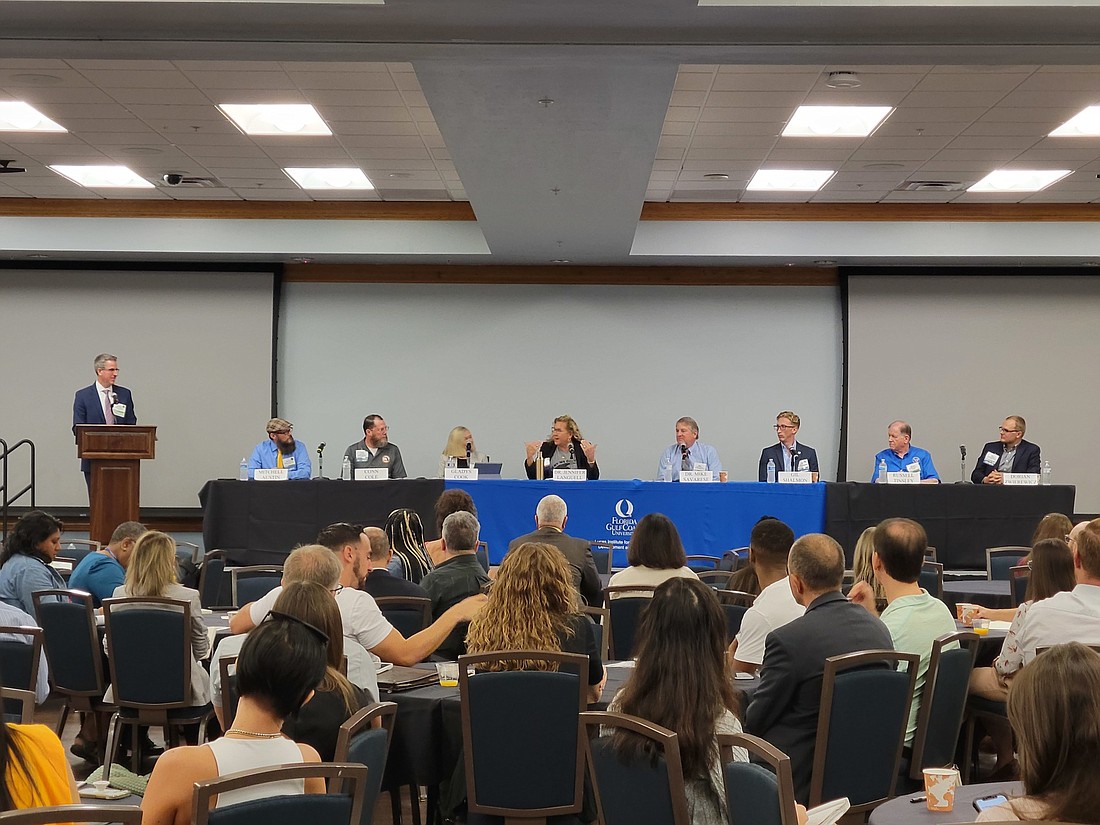While Hurricane Ian is fresh on most people's minds, many in Charlotte County can still recall another massively destructive storm: Hurricane Charley in 2004.
In talking about Ian recovery, Mitchell Austin, principal planner of urban design for the city of Punta Gorda, in Charlotte County, says Charley was the push the community needed to adapt. The city came up with a master plan and climate adaptation plan and started making enhancements like the flood basin improvements in the downtown area, which keeps water from the harbor from flooding the storm water system when it’s high tide.
“For the city of Punta Gorda, Hurricane Charley acted as a catalyst for us to becoming a resilient community,” he says. “We were talking about resiliency before resiliency was cool.”
Austin was one of eight insurance, educational and urban planning professionals who spoke at the Post Hurricane Response and Recovery Event held Nov. 4 in in the Cohen Student Center ballroom at Florida Gulf Coast University in Fort Myers. The free event, where building resilience into communities was a key theme, was hosted by the Southwest Florida Urban Land Institute. Highlights from the speakers include:
Gil Shalmon, director of marketing and public adjuster at Altieri Insurance Consultants, says Floridians should expect insurance premiums to rise. “Like last year, we saw a lot more exclusions like carve outs and coverage (denial) for certain parts of your property,” he says. “So essentially you’ll be paying more money for less coverage.” Shalmon has noticed that one of the issues surrounding increased insurance claims is getting qualified adjusters to come here while figuring out a system to expedite those claims and getting money out quickly.
Conn Cole, interim state NFIP coordinator/state floodplain manager of the Florida Division of Emergency Management, says one way of becoming more resilient is building back smarter. “There’s damage. There is, but if you’ll look at the statistics of the newer built homes, they’re still there,” he says. “The homes that have been there for quite some time going back to the 80s, those were hit the hardest. “We’re going to promote Babcock Ranch,” he continues. “We meet with communities all over the state and so we’re going to start saying ‘this is the smart way to do things.’”
Dorian Zwierewicz, regional director of the Florida Small Business Development Center at FGCU, spoke about the upcoming challenges that will begin to plague business owners soon, specifically declining revenue. Businesses may start noticing that regular clients aren’t here anymore — leading to a decline in revenue. Even currently untouched businesses may start feeling this in the months to come. For those who survived the storm, he recommends setting a reminder for the end of April through May to see if they may need an Economic Injury Disaster Loan. “Generally speaking, there are business owners who did not have physical (damage) and they’re OK on revenue now,” he says. “Sometimes it takes a couple of months to realize ‘we’re actually not making as much money as we did last year.’”
Mike Savarese, department of Marine and Earth Sciences professor at FGCU, echoed Cole’s thoughts. “I do, funnily enough, believe that maybe there’s a real opportunity here,” he says. The Babcock Ranch community had the advantage to build a resilient community from a blank slate. “When you’re living in established communities like we are here in Lee, Collier and Charlotte counties, where we are already burdened by the infrastructure and the developmental pathways that we’ve experienced in the past, it makes it hard to invest money to make those kinds of improvements,” he says, before adding, “When those infrastructural elements are destroyed significantly, there’s an opportunity to basically go in and redo it with a better mindset."
The first step is understanding where the vulnerabilities lie. Savarese points to climate change creating rising sea levels as one. “As sea level rises, we’re going to be subjected to more, on a routine basis, nuisance flooding.” In response, he pointed to flood elevation maps and customized tools that show storm surge and flooding metrics as tools that should be utilized to adapt to the current climate. “This really is an opportunity to sit down and think about how this rebuilding should occur,” he says. “But that process is going to take months and one of my personal fears is that the knee jerk reaction to things restored as quickly as possible back to the previous state is going to prevent us from making best use of that opportunity of being able to do things differently.”
Jennifer Languell, founder and president of Trifecta Construction in Fort Myers and sustainability consultant, says even the best communities still have work to do post-hurricane. “Although we withstood the storm,” she says, “we’re still looking at what we can do better.”






